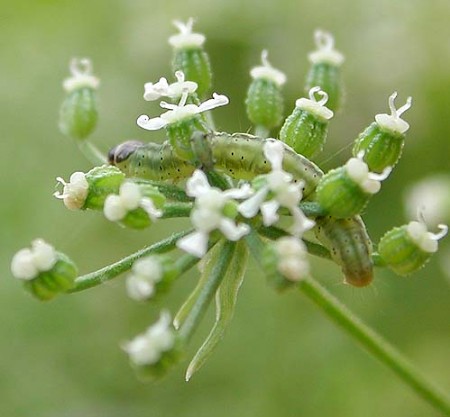32.031 BF695
Agonopterix alstromeriana
(Clerck, 1759)
Wingspan 17-19 mm.
One of the more colourful of the Depressariinae, this species is reasonably common over most of the British Isles.
It can be found on the wing between August and April, and is quite easily attracted by light.
The larvae feed on the flowers and leaves of hemlock (Conium maculatum) between May and July.
- Larva: (description Ian F. Smith):
Foodplant: In leaflets, rolled upwards, of Conium maculatum from May to early July. Sometimes, on flowers and fruits of C. maculatum.
Early instar
Length: 3.5 mm described
Head: Black
Prothoracic shield: Blackish grey.
Body: Yellowish white.
Pinacula: Inconspicuous grey.
Anal plate: Translucent greyish.
Intermediate instar
Length: 10 mm described.
Head: Brown ochre, marked blackish laterally. Posterolateral mark and posterior edge; blackish. Stemmatal area black.
Prothoracic shield: Transparent, clearly showing brown head and body. Distinct black curved band on lateral and posterior (not reaching dorsum) periphery. The blackish posterior edge of the head may appear to form curved bands on the anterior of the shield.
Thoracic legs: Brownish.
Body: Greyish brown above spiracles. Dull yellow below spiracles. Indistinct greyish dorsal line and dorsolateral band.
Spiracles: Black.
Pinacula: Black.
Anal plate: Translucent yellowish brown.
Prolegs: Coloured as venter.
Late instar
Length: 11.5 mm described.
Head: Greenish yellow. Posterolateral mark and posterior edge; blackish. Stemmata black. Stemmatal area whitish.
Prothoracic shield: Translucent, showing greenish yellow when head retracted, or green of body when head extended. Usually a small black dot laterally.
Thoracic legs: Translucent brownish. Base coloured as venter.
Body: Bright green. Abdomen yellow intersegmentally. Greyish green dorsal line and grey dorsolateral band on segments T2 to A8.
Spiracles: Black.
Pinacula: Small, black.
Setae: Transparent colourless.
Anal plate: Translucent pale green.
Prolegs: Coloured as venter. Crochets reddish brown.
Similar species: On C. maculatum:
Depressaria albipunctella lacks black pinacula.
Depressaria sordidatella is very similar. It prefers Anthriscus sylvestris, but sometimes occurs on C. maculatum. Its larva is earlier, maturing in mid June. Its green prothoracic plate lacks black markings or dots.

 UKMoths
UKMoths 



